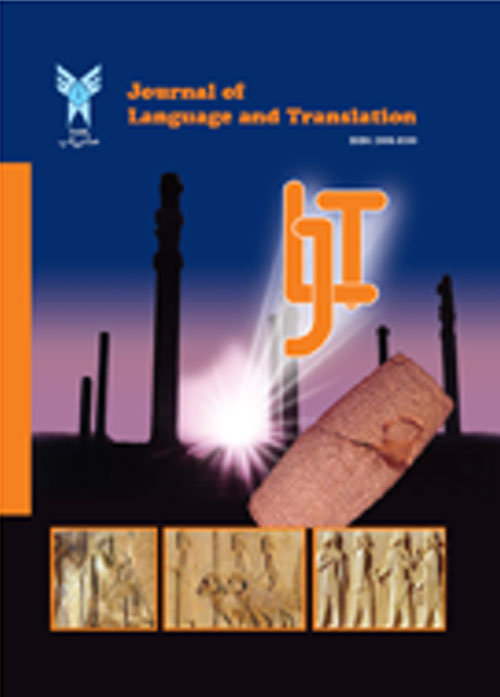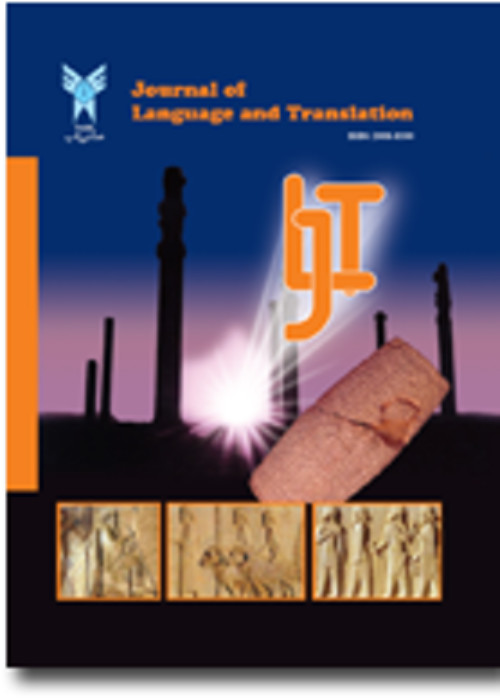فهرست مطالب

Journal of Language and Translation
Volume:2 Issue: 2, Spring 2012
- تاریخ انتشار: 1391/03/01
- تعداد عناوین: 3
-
Pages 1-9The present study aimed at investigating Iranian TEFL teachers’ perspective toward the relationship between SLA research and ELT. The sample of this study consisted of 80 female and male TEFL teachers at different institutes and schools in the city of Tehran. The main instrument was a question- naire designed by Nassaji (2012). It enabled researcher to collect both qualitative and quantitative data. The findings of this study reveal information on different areas like teachers’ familiarity with SLA research, the reason for lack of interest, and the main source they appeal to get the required in- formation for their professional development. The findings indicate that the pedagogical ambience is far from ideal as far as teachers’ involvement with SAL research is concerned. The pedagogical im- plication is that to improve the quality of EFL teaching and learning we are bound to bridge the gap between EFL Teachers and SLA Research.Keywords: Relationship between Research, Pedagogy, SLA research, Teachers’ perspective
-
Pages 11-23The present research study, based on a systematic procedure, investigates the impact of the illocu- tionary and locutionary forces of the pragmatic competence on the Iranian male and female language teaching juniors. By virtue of gaining a persuasive and forceful ultimate goal of this study 400 lan- guage teaching Iranian juniors attended this study. Phase 1 witnessed a T-test where 60 males and females of the subjects were randomly classified into two-30 subject groups. The experimental group was assigned tasks based on illocutionary act measures where the communicative force of the utter- ances was taken into account and the control group was given tasks based on locutionary act where the well-formedness of the utterances was considered for the period of twelve sessions. As the post- test five native like Iranian Ph.D holders in linguistics who had full command of pragmatic compe- tence in general and speech act theory in particular were hired to interview all the 60 subjects to un- ravel their differences. The acquired result revealed that the experimental group was much more versed in pragmatic competence regarding the illocutionary force of speech act theory. Phase 2 was allotted to a correlational study. The researcher intended to look into the degree of correlation be- tween the locutionary and the illocutionary forces. The scores of 30 subjects in illocutionary experi- mental group were correlated with those of the locutionary control group. The coefficient of correla- tion demonstrated that there was a negligible positive correlation between the two variables. In phase 3 a 2x2 factorial design was employed where the120 male and female participants were subjected to the locutionary and illocutionary act. According to the observed F it was proved that the females out- performed the male subjects in both locutionary and illocutionary acts.Keywords: Correlation, Factorial Design, Illocutionary, Locutionary, pragmatic competence, t-test
-
Pages 25-33Computer technology has influenced the realm of language teaching and testing so drastically that no language teaching program could be imagined nowadays without the use digitized software and mul- timedia. This study aims at investigating Iranian EFL learners' performance on paper-based test com- pared with their performance on computer-based test while considering their attitudes towards the computer and learning language through computer. The sample selected for this study consisted of 205 Iranian male and female EFL learners, having been selected randomly from some language insti- tutes and colleges, their age ranging from 17 to 27 years. To materialize the objectives of the study, the researchers used three research instruments: a test in two versions, a questionnaire and an inter- view. The Objective Placement Test (one computer-based and the other paper-based) including, lis- tening, reading and language use was given to participants in two separate administrations. The for- mat of the computer-based version of the test was designed by the researchers so that it could be the same as that of the paper-based version and could have the same level of practicality. The question- naire was based on Min (1998), designed to measure the participants' attitudes towards the computer in general and computer-based language learning in particular. To confirm the questionnaire data, an interview was also randomly conducted with 20 learners. It was found that Iranian EFL learners are mostly exposed to paper-based tests. The findings revealed that although learners showed positive attitude towards computer-based tests and digitized language learning, they performed better on the paper-based test than on the computer-based test.Keywords: EFL learners' attitudes, Computer-based language learning, Computer-based English test, Paper-based English test


